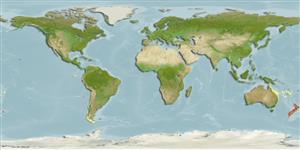Environment: milieu / climate zone / depth range / distribution range
Ecología
marino demersal; rango de profundidad 10 - 100 m (Ref. 42788). Temperate; 17°S - 47°S
Distribución
Países | Áreas FAO | Ecosistemas | Ocurrencias, apariciones | Point map | Introducciones | Faunafri
Southwest Pacific: New Zealand. Eastern Central Pacific: Tonga and Tahiti.
Tamaño / Peso / Age
Maturity: Lm ? range ? - ? cm
Max length : 45.0 cm TL macho / no sexado; (Ref. 42788)
Short description
Morfología | Morfometría
Espinas dorsales (total): 0 - 4; Radios blandos dorsales (total): 16-20; Radios blandos anales: 15 - 19. Head and anterior body depressed. Body scales minute, randomly arranged. Pectoral fins with "squarish" appearance, dorsoposterior margin straight, middle ray longest. A mental barbel present on chin. Respiratory valve inside lower jaw with a dermal appendage expanded vertically in young, without appendage in adults. Both lips with labial fimbriae. Lower portion of body without dermal folds originating from anal fin rays (Ref 42788).
Ranging from estuaries to the continental shelf (Ref. 42788). Feeds on demersal fishes (Ref. 42788). Minimum depth range from Ref. 121942.
Life cycle and mating behavior
Madurez | Reproducción | Puesta | Huevos | Fecundidad | Larva
Paulin, C., A. Stewart, C. Roberts and P. McMillan, 1989. New Zealand fish: a complete guide. National Museum of New Zealand Miscellaneous Series No. 19. 279 p. (Ref. 5755)
IUCN Red List Status (Ref. 130435)
Threat to humans
Harmless
Human uses
Más información
Age/SizeCrecimientoLength-weightLength-lengthLength-frequenciesMorfometríaMorfologíaLarvaDinámica larvariaReclutamientoAbundanciaBRUVS
ReferenciasAcuiculturaPerfil de acuiculturaRazasGenéticaElectrophoresesheritabilidadEnfermedadesProcesamientoNutrientsMass conversion
ColaboradoresImágenesStamps, Coins Misc.SonidosCiguateraVelocidadTipo de nataciónSuperficie branquialOtolitosCerebrosVisión
Herramientas
Special reports
Download XML
Fuentes de Internet
Estimates based on models
Preferred temperature (Ref.
123201): 12 - 20.6, mean 16.6 °C (based on 64 cells).
Phylogenetic diversity index (Ref.
82804): PD
50 = 1.0000 [Uniqueness, from 0.5 = low to 2.0 = high].
Bayesian length-weight: a=0.00631 (0.00266 - 0.01494), b=3.11 (2.90 - 3.32), in cm total length, based on LWR estimates for this (Sub)family-body shape (Ref.
93245).
Nivel trófico (Ref.
69278): 4.5 ±0.80 se; based on food items.
Resiliencia (Ref.
120179): Medio, población duplicada en un tiempo mínimo de 1.4-4.4 años (Preliminary K or Fecundity.).
Fishing Vulnerability (Ref.
59153): Low to moderate vulnerability (35 of 100).
